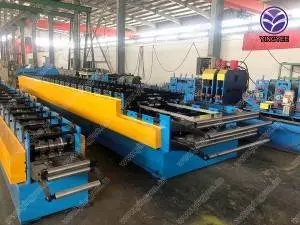
The Roller Shutter Door Making Machine A Revolution in Modern Manufacturing
In the modern industrial landscape, the efficiency and quality of products significantly influence a company’s success. One of the essential components in this realm is the roller shutter door, widely used in commercial, industrial, and residential settings for security and convenience. The roller shutter door making machine has transformed the manufacturing process, providing innovative solutions for producing high-quality shutters with speed and precision.
The Importance of Roller Shutter Doors
Roller shutter doors are favored for their robustness, security, and ease of operation. They can be found in warehouses, garages, businesses, and retail environments, offering protection against theft and environmental elements. Their effectiveness stems from their structural design, which allows them to roll up vertically, saving space and providing a sleek, modern aesthetic. Given their demand, the production of roller shutter doors must be both efficient and scalable, making the roller shutter door making machine an indispensable asset in factories.
The Technology Behind Roller Shutter Door Making Machines
The roller shutter door making machine operates through a series of advanced technologies that enhance its efficiency and reliability. These machines typically consist of several key components a decoiler, a roll forming unit, a cutter, and a stacker.
1. Decoiler The process begins with the decoiler, which unwinds the raw material coil—usually made of galvanized steel or aluminum. This coil is pre-treated for rust resistance and durability.
2. Roll Forming Unit Next, the decoiled material enters the roll forming unit, where it is shaped into the desired profile through a series of rollers. This step is crucial as it determines the door's strength and functionality. The roll former ensures that the produced shutter slats maintain uniformity in thickness and length.

3. Cutter After the slats are formed, they are cut to specific lengths using an automated cutter. This ensures that each piece adheres to the required specifications, enhancing the overall quality of the final product.
4. Stacker Finally, the finished slats are neatly stacked by an automatic stacking unit, ready for packaging and shipping. This automation reduces manual handling, minimizes the risk of damage, and improves workplace safety.
Benefits of Using a Roller Shutter Door Making Machine
Investing in a roller shutter door making machine offers numerous advantages for manufacturers. Firstly, it significantly increases production speed. Traditional methods might involve more manual labor and longer processing times, whereas modern machines can produce large volumes of shutters in a fraction of the time.
Secondly, the precision of automated machines ensures consistent quality across all products, with minimal variation. This reliability helps build a reputation for quality, which is crucial for customer satisfaction and repeat business.
Moreover, modern roller shutter door making machines are often designed with energy efficiency in mind, reducing operational costs. Many of these machines employ advanced computer control systems, allowing for easier setup changes and adjustments for different door specifications.
Conclusion
The roller shutter door making machine is more than just a piece of manufacturing equipment; it is a cornerstone of modern production techniques in the door industry. By harnessing automation and precision engineering, manufacturers can meet the growing demand for high-quality roller shutter doors while maintaining efficiency and cost-effectiveness. As the market continues to evolve, investing in such technology will be critical for businesses looking to thrive in an increasingly competitive landscape. The future of roller shutter production lies in these innovative machines, setting a new standard for speed, quality, and reliability in manufacturing.